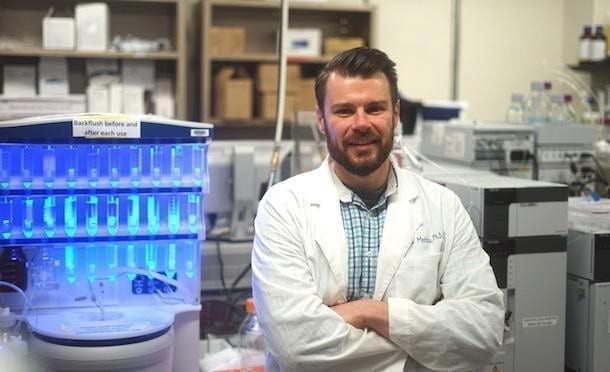
Researchers from North Carolina State University have found that an elastic polymer possesses broad-spectrum antimicrobial properties, allowing it to kill a range of viruses and drug-resistant bacteria in just minutes – including methicillin-resistant Staphylococcus aureus (MRSA).
“We were exploring a different approach for creating antimicrobial materials when we observed some interesting behavior from this polymer and decided to explore its potential in greater depth,” says Rich Spontak, co-corresponding author of a paper on the work and Distinguished Professor of Chemical and Biomolecular Engineering at NC State. “And what we found is extremely promising as an alternate weapon to existing materials-related approaches in the fight against drug-resistant pathogens. This could be particularly useful in clinical settings – such as hospitals or doctor’s offices – as well as senior-living facilities, where pathogen transmission can have dire consequences.”
The polymer’s antimicrobial properties stem from its unique molecular architecture, which attracts water to a sequence of repeat units that are chemically modified (or functionalized) with sulfonic acid groups.
“When microbes come into contact with the polymer, water on the surface of the microbes interacts with the sulfonic acid functional groups in the polymer – creating an acidic solution that quickly kills the bacteria,” says Reza Ghiladi, an associate professor of chemistry at NC State and co-corresponding author of the paper. “These acidic solutions can be made more or less powerful by controlling the number of sulfonic acid functional groups in the polymer.”
The researchers tested the polymer against six types of bacteria, including three antibiotic-resistant strains: MRSA, vancomycin-resistant Enterococcus faecium, and carbapenem-resistant Acinetobacter baumannii. When 40% or more of the relevant polymer units contain sulfonic acid groups, the polymer killed 99.9999% of each strain of bacteria within five minutes.
The researchers also tested the polymer against three viruses: an analog virus for rabies, a strain of influenza and a strain of human adenovirus.
“The polymer was able to fully destroy the influenza and the rabies analog within five minutes,” says Frank Scholle, an associate professor of biological sciences at NC State and co-author of the paper. “While the polymer with lower concentrations of the sulfonic acid groups had no practical effect against human adenovirus, it could destroy 99.997% of that virus at higher sulfonic acid levels.”
One concern of the researchers was that the polymer’s antimicrobial effect could progressively worsen over time, as sulfonic acid groups were neutralized when they interacted with positively charged ions (cations) in water. However, they found that the polymer could be fully “recharged” by exposing it to an acid solution.
“In laboratory settings, you could do this by dipping the polymer into a strong acid,” Ghiladi says. “But in other settings – such as a hospital room – you could simply spray the polymer surface with vinegar.”
This “recharging” process works because every time one of the negatively charged sulfonic acid groups combines with a cation in water – which can happen when the polymer comes into contact with microbes – the sulfonic acid group becomes electrically neutral. That makes the acid group ineffective against microbes. But when the neutralized polymer is subjected to acid, those functional groups can exchange bound cations with protons from the acid, making the sulfonic acid groups active again – and ready to kill microbial pathogens.
“The work we’ve done here highlights a promising new approach to creating antimicrobial surfaces for use in the fight against drug-resistant pathogens – and hospital-acquired infections in particular,” Ghiladi says.
“Functional block polymers like this are highly versatile – usable as water-treatment media, soft actuators, solar cells and gas-separation membranes – and environmentally benign since they can be readily recycled and re-used,” Spontak adds. “These features make them particularly attractive for widespread use.
“And this work focused on only one polymer series manufactured by Kraton Polymers,” Spontak says. “We are very eager to see how we can further modify this and other polymers to retain such effective and fast-acting antimicrobial properties while improving other attributes that would be attractive for other applications.”
Learn more: Self-sterilizing polymer proves effective against drug-resistant pathogens
The Latest on: Self-sterilizing polymer
[google_news title=”” keyword=”self-sterilizing polymer” num_posts=”10″ blurb_length=”0″ show_thumb=”left”]
via Google News
The Latest on: Self-sterilizing polymer
- WST West Pharmaceutical Services, Inc.on May 2, 2024 at 9:00 am
This segment also provides drug containment solutions, including Crystal Zenith, a cyclic olefin polymer in the form of vials, syringes, and cartridges; and self-injection devices; and a range of ...
- Letter: Actions and consequenceson April 28, 2024 at 5:00 pm
Wade, tubal ligations, the self-sterilization of young women in the U.S., has doubled to 450 per 100,000. Now that’s quite an accomplishment — social engineering at its finest. Have something ...
- Top 5 Best Glass Baby Bottles in 2024on April 22, 2024 at 4:07 am
Some of these include bottles with smart sensors that track feeding patterns and temperature, bottles with self-sterilizing capabilities, and bottles with customizable flow rates and nipple shapes.
- Self-polarized RGB device realized by semipolar micro-LEDs and perovskite-in-polymer films for backlight applicationson April 3, 2024 at 5:00 pm
2024.230210 , discusses self-polarized RGB device realized by semipolar micro-LEDs and perovskite-in-polymer films for backlight applications. Polarized light is crucial in numerous applications ...
- 13 Best Air Purifiers for Clean Breathing (2024)on November 16, 2023 at 9:12 am
It also has a bunch of other great qualities such as auto-cleaning, U.V. light self-sterilization, and an air quality display to keep you in the know. Although not all of this is needed ...
- Unbreakable Design: The Polymer Mechanochemistry of Self-Healing Materialson October 18, 2023 at 11:14 pm
What if we could invent materials that can repair themselves when damaged? Polymer molecules in various states – solid, melt, solution – are susceptible to covalent bond changes in response to ...
- Why Is Continuous Glucose Monitoring So Hard?on December 2, 2018 at 11:21 pm
The finished assembly also has to be sterilized, of course, so it has to be able to withstand the rigors of irradiation, the most common method of sterilizing medical devices. My collection of ...
- The Ethics Of Self-Driving Cars Making Deadly Decisionson October 29, 2015 at 9:14 am
Self-driving cars are starting to pop up everywhere as companies slowly begin to test and improve them for the commercial market. Heck, Google’s self-driving car actually has its very own driver ...
via Bing News










